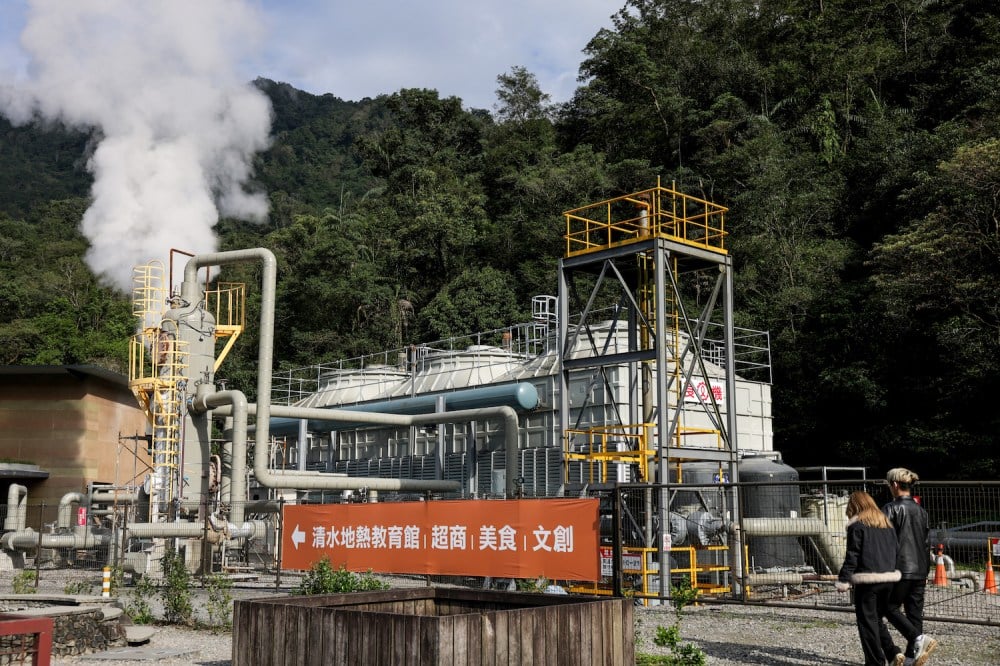Taiwan is experiencing an energy crisis. As the island completes a phaseout of nuclear power plants—long the bedrock of its energy mix—plans for a promised offshore wind buildup have sputtered. All the while, industry has become more dependent on imports of liquefied natural gas. But that source is not only dirty—it also leaves the island at risk of a blockade and other forms of coercion by China. In 2024, electricity rates in Taiwan hiked twice in the same year after two consecutive years of increases, reaching record levels for industrial users. Another rate hike could be coming this year. Blackouts have become more common.
Taiwanese leaders could find relief if they harness the heat beneath their feet. Sandwiched between two tectonic plates on the Pacific Rim, Taiwan is rich in geothermal resources. Although they have so far mostly gone untapped, that could soon change. President Lai Ching-te has expressed strong support for growing Taiwan’s geothermal footprint to produce more clean power and shore up the island’s grid.
Taiwan’s economics ministry last year rolled out new guidelines to encourage geothermal development. In April, Google announced a deal with Swedish geothermal developer Baseload Capital to build a small pilot-scale geothermal energy facility to power its existing Taiwanese data centers. The companies have not yet announced the plant’s exact location, but drilling has already begun on Taiwan’s east coast. In a show of support from the government, top Lai administration officials in April took part in Taiwan’s leading geothermal industry summit.
“Right now, there’s a very positive feeling in Taiwan for geothermal,” said Alexander Helling, Baseload Capital’s chief executive. “There’s a big opportunity.”
Taiwan was among the earliest countries in Asia to develop geothermal power. The island began investing heavily in the resource in the 1970s, and its first geothermal plant came online in 1981. But the plant’s power station faced problems immediately as crystalline deposits in the well diminished its energy output—and in 1993, Taiwan gave up on and closed the project.
By then, Taiwan—like nearby Japan and South Korea—had staked its future on a different source of power: nuclear energy. All three places have limited land and no real oil or gas reserves. Nuclear power promised to generate abundant electricity regardless.
Taiwan’s nuclear industry was tied to politics. The Taiwanese government built its nuclear power plants under the authoritarian rule of the Kuomintang (KMT), the Chinese nationalists who declared martial law on the island in 1949 after fleeing communist defeat in mainland China. Since Taiwan’s transition to democracy in the 1990s, the KMT has been the island’s leading conservative party. While the party has backed away from its support for eventual reunification, which is widely opposed by Taiwanese voters, it supports closer relations with China.
The KMT’s main opponent is the Democratic Progressive Party (DPP), which formed in 1986 as an outgrowth of a pro-democracy movement just months after the Chernobyl nuclear meltdown in the Soviet Union. In addition to their differences over Taiwan’s future—the DPP is in favor of preserving the island’s status quo and challenging Beijing’s sovereignty claims—one of the most polarized issues between the two parties has always been nuclear power. Lai is a member of the DPP.
The DPP’s anti-nuclear stance eased throughout the 2000s as concerns over climate change rose. But the March 2011 Fukushima-Daiichi disaster in Japan revived the party’s activist stance. In 2014, DPP-affiliated protesters pressured then-President Ma Ying-jeou, of the KMT, to pause construction on Taiwan’s fourth nuclear power plant. After the DPP’s Tsai Ing-wen swept to victory in 2016 presidential elections, the project’s fate was sealed.
Under Tsai, the DPP passed a law that set a goal of closing Taiwan’s three other nuclear power plants. But as the DPP forged a more antagonistic relationship with China, the island depended more than ever on its so-called silicon shield: the theory that Taiwan’s semiconductor industry is so important to the global economy that Beijing would think twice about an invasion. Taiwan represents roughly one-fifth of global semiconductor manufacturing capacity and has more than 90 percent of the world’s capacity to churn out advanced microchips.
Once Taiwan’s nuclear reactors started going offline in 2018, electricity prices surged and blackouts grew more frequent. The final reactor shut down in May. Taiwan Semiconductor Manufacturing Company, the giant behind the silicon shield, warned that it would now pay the highest electricity prices in the world at home.
In response, some anti-nuclear factions in Taiwan have softened their approach. Lai has suggested he would be open to restarting the nuclear plants. In August, Taiwanese voters will cast ballots in a KMT-organized referendum on whether to restart the most recent plant to shut down. But as the KMT becomes ensnared in a growing list of controversies, the plebiscite’s prospects are uncertain.
The KMT and DPP align far more in their aspirations for geothermal power. The energy source behaves like nuclear power in that it has consistent output, satisfying the KMT. The DPP likes that geothermal energy is renewable and doesn’t generate radioactive waste.
At the start of the nuclear phaseout in 2016, the DPP promised that offshore wind turbines and solar panels would make up for the lost atomic energy. But construction proved harder than leaders thought, and the weather-dependent nature of renewables meant that replacing reactors’ consistent output required using more fossil fuels. Coal and gas made up nearly 80 percent of Taiwan’s electricity mix as of last year, according to data from public utility Taipower.
So leaders gave geothermal another look. In 2021, a developer called Fabulous Power revived the original site of Taiwan’s debut geothermal station from the 1980s to sell energy to Taipower. Although it only took one year for the developer to bring the plant back online, it took four for the government to get the operating permits in order, said Ricky Huang, an advocate for geothermal technology in Taiwan and the co-founder of the nonprofit Climate Era Catalyst.
Bureaucracy was hardly the only problem for embracing a new form of domestic energy. Government surveys of the island’s geothermal resources showed that as much as 90 percent of underground hot water reservoirs—the conventional source of geothermal power—were located on Indigenous land.
Taiwan’s Austronesian Indigenous people had borne the brunt of the island’s other energy development. In the 1980s, the government secretly opened a dump site for low-level nuclear waste on Lanyu Island, the tropical homeland of the Tao people, one of Taiwan’s 16 Indigenous tribes.
While support for the nuclear repository today is mixed on Lanyu—it offers some of the best-paying jobs in what is otherwise mostly a tourist economy—Indigenous opposition to solar power is greater, since a large share of panels ended up on aboriginal land, said Fran Minchen, a member of the Paiwan Indigenous group native to southern Taiwan.
“When Indigenous people see solar panels, we think the government is here to take our land,” she said, adding, “Geothermal is in the same situation.”
While Helling, the Swedish executive, declined to disclose the exact location of Baseload Capital’s plant in Taiwan, he said it was located outside an Indigenous reserve—areas of land where tribal members can live with a degree of autonomy.
Minchen, who previously worked as a Taiwanese diplomat in New Zealand, thinks that the country’s geothermal industry could be a good model for Taiwan. Geothermal energy generates more than one-fifth of New Zealand’s electricity and is its second-largest source of power.
In New Zealand, many of the best geothermal resources were located on Maori land. But the industry cut the Maori into the deals; a geothermal project owned by the Maori’s land trust was among the first big operators in New Zealand. New Zealand’s free trade agreement with Taiwan includes one of the world’s only specific chapters outlining Indigenous cooperation.
Fairer, more deliberate deals with Taiwan’s Indigenous groups aren’t the only solution to scaling up geothermal power on the island. The total amount of power that could be generated from tapping into the conventional geothermal resources on or near Indigenous lands is about 989 megawatts—just under 2 percent of Taiwan’s total electricity needs.
Currently, Taiwan is using less than 8 megawatts of that potential geothermal energy. But the government has set a target of more than doubling that to 20 megawatts by the end of the year. The target then skyrockets fiftyfold to 1 gigawatt—or 1,000 megawatts—by 2027, with steady growth to 6 gigawatts by 2050. Reaching anything beyond 1 gigawatt using conventional geothermal technology is “literally impossible,” said Huang, the geothermal advocate.
That’s good news for U.S. start-ups such as Fervo Energy and Sage Geosystems, which are pioneering the use of fracking technologies to drill deeper to access geothermal heat. Conventional geothermal companies get energy from shallow reservoirs of underground water heated by the planet’s magma core. Fracking technology would allow companies to dig deep enough to harvest heat from the planet’s molten depths.
Using fracking tools for geothermal could provide two benefits for Taiwan: bolstering the island’s supply of clean, reliable, and secure energy while also balancing its trade with the United States amid the Trump administration’s tariff war.
“When I think of potential export markets for geothermal, Taiwan is basically at the top of the list,” said Wilson Ricks, a Princeton University researcher who tracks geothermal technology. “I don’t think there’s a place on Earth where the need is higher for something like this.”
While Taiwan is currently focused on building out conventional geothermal resources, it could generate at least 32 times as much power using next-generation fracking technologies, according to a recent study by scientists at Taiwan’s Industrial Technology Research Institute.
Last October, state-owned petroleum company CPC Taiwan and the research institute Academia Sinica started drilling an exploratory well on the island’s northeast coast. For the industry to scale up, however, Huang said Taiwan needs to carry out a more rigorous geological survey to confirm the best drilling locations and make permits easier to obtain.
As a first step, Huang is working with lawmakers to pass a bill that would lift restrictions on geothermal drilling in national parks—opening up more land to developers outside of Indigenous reserves. The legislation would also streamline permit application rules.
Geothermal may lose its luster once drilling begins. Fracking technology can spark earthquakes, a perennial problem in Taiwan. In 2017, seismic activity from a geothermal project in South Korea triggered a damaging earthquake that set the country’s geothermal industry back years.
Huang isn’t worried. “We’re very used to earthquakes. There’s a joke that if you’re in a room when an earthquake happens and if you’re very chill and just sit there, you’re probably Taiwanese,” he said.
Even if there is a tremor in Taiwan, Huang said the energy source has something going for it that nuclear power never did: broad political appeal. “Geothermal is one of the most cross-partisan energy resources,” he said.
The post Taiwan Is on the Cusp of an Energy Revolution appeared first on Foreign Policy.




